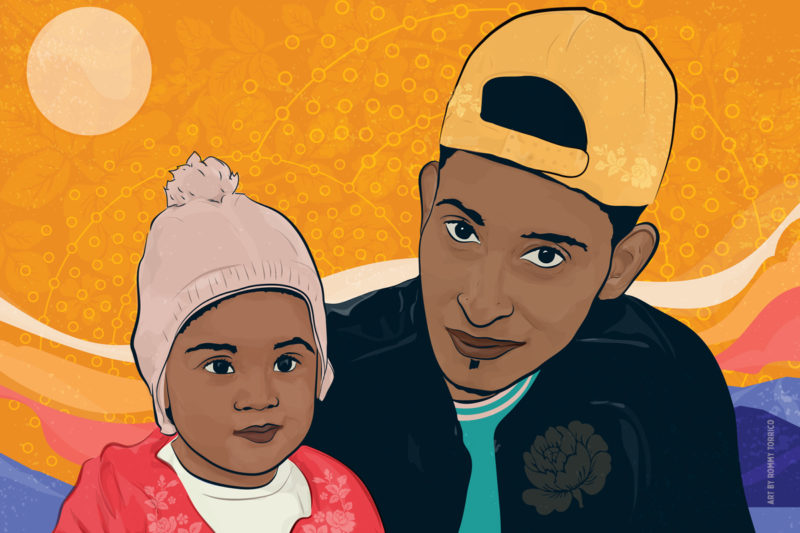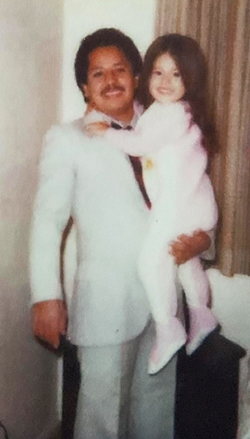The Image America Shouldn’t Need
My perspective, as an immigration reporter, is that if you haven’t been moved by now by the many reports of abuses, injustices, in-custody deaths, and bodies that have turned up in the borderlands, then you cannot be moved.

This piece is published in partnership with NYR Daily.
The photo is inescapable. First published by the Mexican newspaper La Jornada and later by the Associated Press, it quickly circulated on social media. Not long after, the image flashed across television stations and news sites around the country. By Wednesday morning, it was on the front page of the New York Times.
The image shows the bodies of 25-year-old Óscar Alberto Martínez Ramírez and his daughter, Valeria, who was almost 2 years old. On the banks of the Rio Grande river, they were captured by journalist Julia Le Duc in a final embrace. They died migrating.
According to Le Duc, Martínez, his wife, Tania Vanessa Ávalos, and their daughter Valeria had begun migrating to the United States from El Salvador. They’d been in Tapachula in southern Mexico, where they applied for humanitarian visas that would have allowed them to stay and work in Mexico for a year. But they wanted “the American dream,” Le Duc said, so they took a bus to ask for asylum at the border. Once at the international bridge, they were told that the U.S. immigration office was closed, and there were many others ahead of them waiting for asylum interviews.
Óscar decided to cross the Rio Grande in order to apply for asylum in Brownsville, Texas. He and Valeria went first. Óscar reached the United States side and left Valeria on the riverbank to go help his wife. But Valeria didn’t understand what was happening and followed her father back into the Rio Grande. “The current took them both,” Le Duc reported.
I first saw the image on my Twitter timeline, unexpectedly and without warning, on Tuesday evening. It made me cry. As a writer, I have covered immigration on and off for ten years. For almost four years, immigration has been my daily beat at Rewire.News. But I have never, and will never, become accustomed to such atrocities. I’m routinely astounded by the scope of the United States’ collective amnesia about the cruel part our country plays in the lives of asylum-seekers.
In the past two and a half years, President Trump has ushered in one of the most anti-immigrant periods in modern U.S. history. But I don’t blame only the Trump administration. On Wednesday, Chuck Schumer, Democrat of New York, presented the AP photo on the Senate floor and demanded Trump look at it. Schumer’s use of Óscar and Valeria’s photo was purely political—and completely disingenuous. The Democratic Party has long pretended to be pro-immigration reform, claiming its hands were tied—even as it ran a deportation machine at full speed and the bodies piled up along the border on its watch.
I’m a journalist, and a person of color in the United States. Unlike those who’ve suggested that no one should dare look away from the image, I’ve never needed convincing that “the other” is human. The photos people need to see are of Óscar and Valeria together, alive, to remind them they were people, not bodies. They were a father and daughter whose lives were taken suddenly, rather than convenient symbols of failed U.S. immigration policies. They are, in a real sense, my people: I am the daughter of a Mexican immigrant who first entered the United States in the 1970s without authorization. My father only began to tell me bits and pieces of his migration story when I was in my mid-20s. I still don’t know the full story; he says he will tell me on his deathbed.
But I can guess at the lingering pain of his journey to the United States, and I know it continues to show up in his life in unexpected ways, all these years later. Although he will not tell me the whole story, I know that when my father was migrating, another young man developed bleeding blisters on his feet and then broke his ankle. He was barely able to walk and was slowing my father’s group down. The coyote, or paid smuggler, who was helping my father, another family member, and other migrants across the border told the group that they had to leave the young man behind, that someone else would find him and help him.

My father said he felt like had no choice but to keep moving, but decades later I know he still thinks about the man they left behind. He worries whether anyone ever found that boy, wonders if he became one of the borderlands’ many disappeared. Border Patrol finds the remains of 375 migrants on average every year, according to the New York Times. But because the accounting is limited to only those remains CBP agents come across, an accurate border-wide death count cannot be determined.
My father’s trauma belongs to him, but it has also been transmitted across the generations of our family. Even as a kid—unaware of my father’s immigration status—I nevertheless picked up on his anxiety. In elementary school, if my dad was just a few minutes late picking me up, I’d sit on the school’s front steps and weep. The crosswalk guard couldn’t understand my distress. He couldn’t piece together the logic behind my sense, haltingly expressed between sobs, that someone must have “taken” my father.
Because of my family’s experience and my professional work, I oppose the media circulation of this image: It is unnecessary, misguided, dehumanizing, and unwarranted. This family’s private, personal tragedy has become a footnote in a larger partisan fight over the president’s immigration policies. Many, including no doubt the editors of the AP and the New York Times, will argue that there is a larger public interest: This “iconic image,” they will say, has the power to stir the public, change minds, mobilize political action.
Óscar and Valeria’s photo has been compared to the 2015 image of Aylan Kurdi, a 3-year-old Syrian refugee whose body washed ashore in Turkey when his family tried to reach Europe. As the Columbia Journalism Review reported: “CNN, The Guardian, and others noted that the Kurdi image had a profound, galvanizing impact on the tenor of the migration debate in Europe.” The AP wrote that the image of Óscar and Valeria “may have the same impact in focusing international attention on migration to the US.”
But would these same news organizations dare to use—at the top of the hour on their cable shows or on the homepages of their sites—such graphic pictures of dead Americans who were the victims of the latest school shooting? I find it hard to believe that we would see the cadavers of dead, white, U.S. citizens on the evening news. I think that editors and producers would respect their privacy. Their dignity. Their families’ feelings. Politicians would send their thoughts and prayers instead of using pictures of their bloody corpses to score points about gun control on C-Span.
But what about the “public interest”? On Tuesday night, the writer Mikki Kendall tweeted that she didn’t understand “why people think pictures of dead people will incite America to do… well anything. This is still the country that made postcards of lynchings.”
Before these two deaths, many Americans were waking up to the horrors immigrants have experienced for decades because of the particular way that Trump has made immigration—or rather, the push to end non-white migration to the United States—the central focus of his administration. As of today, 24 people have died in federal immigration custody under the Trump administration, including six Central American children. Just last week, we read about the negligent conditions and “stench” of border-processing facilities for detained families, and watched a Justice Department lawyer argue that the federal government was not required to provide them with soap, toothbrushes, or beds.
Under the Trump administration, there have been news reports about a detained father dying by suicide after being separated from his family at the border. A crying toddler on the cover of Time magazine became the face of the family separation policy. ProPublica published audio of separated children crying for their mothers inside a border processing facility. The New York Times published an interactive map on which readers could click on areas of the borderlands and listen to calls made by lost, injured, and dying migrants, some of which may be their last known dispatches. Many asked for help, others begged for water, some simply sobbed. We have seen images of asylum-seeking families tear-gassed at the border.
Many have asked, “How did this happen? How did we get here? This isn’t the country that I know.” But this is the country that many of us know well. There is a common belief that immigration reporting humanizes immigrants or inspires empathy. But I’m beginning to wonder if we’re simply a country desensitized to these horrors, incapable of seeing these “others” as human. My perspective, as an immigration reporter, is that if you haven’t been moved by now by the many reports of abuses, injustices, in-custody deaths, and bodies that have turned up in the borderlands, then you cannot be moved. The argument that people need to see actual dead brown and Black bodies to understand injustice against people of color betrays a gruesome prejudice—and, as Kendall suggests, our country’s history shows that these sorts of images are unlikely to mobilize action.
Today, I am thinking about Tania Vanessa Ávalos, the wife and mother who watched her loved ones die in the Rio Grande. No doubt, there are reporters trying to track her down. Perhaps they have already; I haven’t had the heart to look. I will be thinking about the way that her pain has become political fodder in a country that refused to take her family in.
